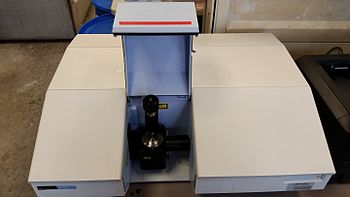 Comment: Probably by accident, there are now two copies of this draft. How does either of these copies differ from the existing article? Robert McClenon (talk) 04:24, 18 November 2016 (UTC)
Comment: Probably by accident, there are now two copies of this draft. How does either of these copies differ from the existing article? Robert McClenon (talk) 04:24, 18 November 2016 (UTC)

Fourier Transform Infrared Spectroscopy (FTIR) is an absorption spectroscopic technique to that has been used for analyzing the fundamental molecular structure of geological sample in recent decades. Like other infrared spectroscopy, the molecules in the sample are excited to a higher energy state due to the absorption of infrared (IR) radiation emitted from the IR source in the instrument, which results in vibrations of molecular bonds. The intrinsic physicochemical property of each particular molecule determines its corresponding IR absorbance peak, and therefore can provide characteristic fingerprints of functional groups (e.g. C-H, O-H, C=O, etc.). Most of the applications of FTIR on geology focus on the range of mid-infrared range of light, which is approximately 4000 to 400 cm−1.[1][2]
In geosciences research, FTIR is applied extensively in measuring volatiles in glass and minerals in order to better understand the magmatic processes. It can also be used to estimate the explosion potential in volcanic setting.[1] The study of chemotaxonomy of early life on earth can also be facilitated by the advancing spectroscopic technology. The biological affinities of both microfossils and macrofossils can be better understand by processing microstructural analysis using FTIR.[3][4] These applications are discussed in details in the following sections.
- ^ a b Chen, Y., Zou, C., Mastalerz, M., Hu, S., Gasaway, C., & Tao, X. (2015). Applications of Micro-Fourier Transform Infrared Spectroscopy (FTIR) in the Geological Sciences—A Review. International Journal of Molecular Sciences,16(12), 30223-30250.
- ^ Åmand, L. E., & Tullin, C. J. (1997). The Theory Behind FTIR analysis. Department of Energy Conversion Chalmers University of Technology, Göteborg, Sweden.
- ^ Zodrow, E. L., D'Angelo, J. A., Mastalerz, M., & Keefe, D. (2009). Compression–cuticle relationship of seed ferns: Insights from liquid–solid states FTIR (Late Palaeozoic–Early Mesozoic, Canada–Spain–Argentina). International Journal of Coal Geology, 79(3), 61-73.
- ^ Zodrow, E. L., Mastalerz, M., Orem, W. H., S̆imůnek, Z., & Bashforth, A. R. (2000). Functional groups and elemental analyses of cuticular morphotypes of Cordaites principalis (Germar) Geinitz, Carboniferous Maritimes Basin, Canada. International Journal of Coal Geology, 45(1), 1-19.